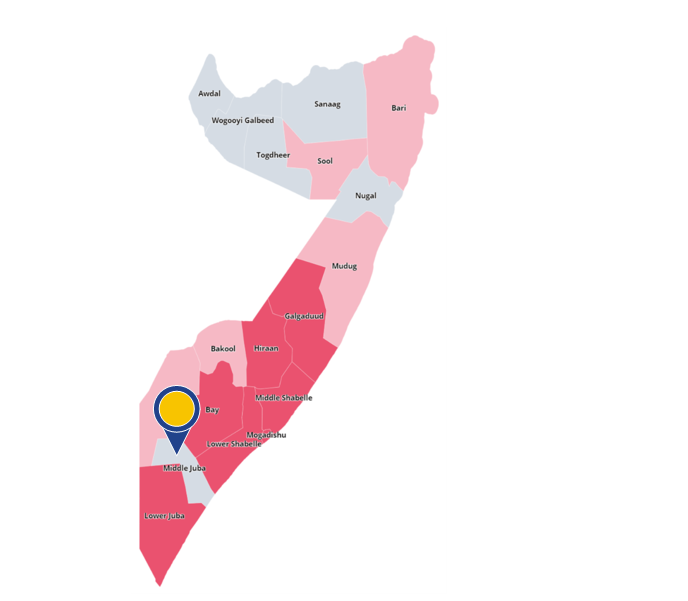COMMON ANALYSIS
Last update: June 2023
The situation in Middle Juba should be seen in light of the situation in, among others, Gedo and Lower Juba regions.
Main COI references: [Security 2023, 2.1.2, pp. 67-72; COI Update 2023, 1.2.2., p. 11; 1.3.4., pp. 16-19; Security 2021, 2.1.2, p. 53; Actors, 7.1., pp. 77-79]

General information
Middle Juba region is located in the southern part of Somalia. It has three districts. It is one of the poorest areas of Somalia. The region’s capital is Bu’aale.
The region has a very diverse population in terms of clan representation. The most populous ethnic group in the region is the Somali Bantu. The two politically and militarily strongest clans in Middle Juba are the Aulihan (Darood) and the Mohamed Zubier/Ogaden (Darood) clans, both residing on the west bank. The east bank of the region is the most ethnically diverse and complex. Other clans and sub-clans in the region include the Digil-Mirifle or Rahanweyn, and several Hawiye sub clans.
In 2021, UNOCHA estimated the population of Middle Juba region at 363 930 inhabitants.
Background and actors involved in armed confrontations
Middle Juba is the sole Somali region that entirely and exclusively falls under Al-Shabaab’s control. As of November 2022, Al-Shabaab reportedly controlled almost all Middle Juba, with only small areas at the border being under mixed or unclear control. The group reportedly concentrates its governance apparatus and hierarchy in Middle Juba region, maintaining the group’s ‘official’ headquarters in the regional town of Jilib where clashes between Al-Shabaab’s factions occurred in early April 2023 around the group’s leadership.
Al-Shabaab also plays the role of ‘stability provider’ in the area, as inter-clan conflict has reportedly been suppressed by the group. Al-Shabaab was reported to be involved in all the security incidents affecting the region during the reference period from July 2021 to November 2022.
Nature of violence and examples of incidents
Illustrative security incidents reported during the reference period include, for example, the killing of a senior Al-Shabaab official in October 2022 by a US drone attack.
In August 2022 Al-Shabaab militants publicly shot six individuals over accusations of cooperation with the intelligence agencies of Somalia, Kenya and the US.
Incidents: data
ACLED recorded 9 security incidents (an average of 0.1 security incidents per week) in Middle Juba between 1 July 2021 and 30 November 2022. Out of those incidents, 2 were coded as ‘explosions/remote violence’, and 7 as ‘violence against civilians’. In the period from 1 December 2022 to 14 April 2023, 3 security incidents were recorded in Middle Juba representing an average of 0.2 security incidents per week.
Geographical scope
During the reference period, security incidents occurred in two districts, with the most of them being recorded in Jilib (7 incidents), followed by Saakow district.
Fatalities among civilians and non-civilians
In the reference period, ACLED recorded a total of 19 fatalities in the region. In the 4.5 months between December 2022 and mid-April 2023, ACLED recorded a total of 6 fatalities in the region. Compared to the figures for the population in the region as from 2021, this represents approximately 7 fatalities per 100 000 inhabitants for the whole reference period.
Displacement
Between July 2021 and November 2022, 1 775 individuals were newly displaced from Middle Juba, according to PRMN. Most of them (91 %) were displaced to the neighbouring region of Lower Juba. In the same period, conflict and insecurity resulted in 642 individuals arriving in Middle Juba from Bay.
Between December 2022 and March 2023, 482 individuals were newly displaced from Middle Juba, according to PRMN.
Further impact on civilians
Middle Juba region is reportedly very underdeveloped and lacks infrastructure, with the exception of the ribbon of deteriorated highway passing through Jilib from Mogadishu to Kismayo.
Looking at the indicators, at the time of writing, it can be concluded that in the region of Middle Juba, there is, in general, no real risk for a civilian to be personally affected within the meaning of Article 15(c) QD.
While Middle Juba is significantly affected by human rights violations by Al-Shabaab, who is in control of the area, these violations should be examined in the context of refugee status or Article 15(b) QD.
